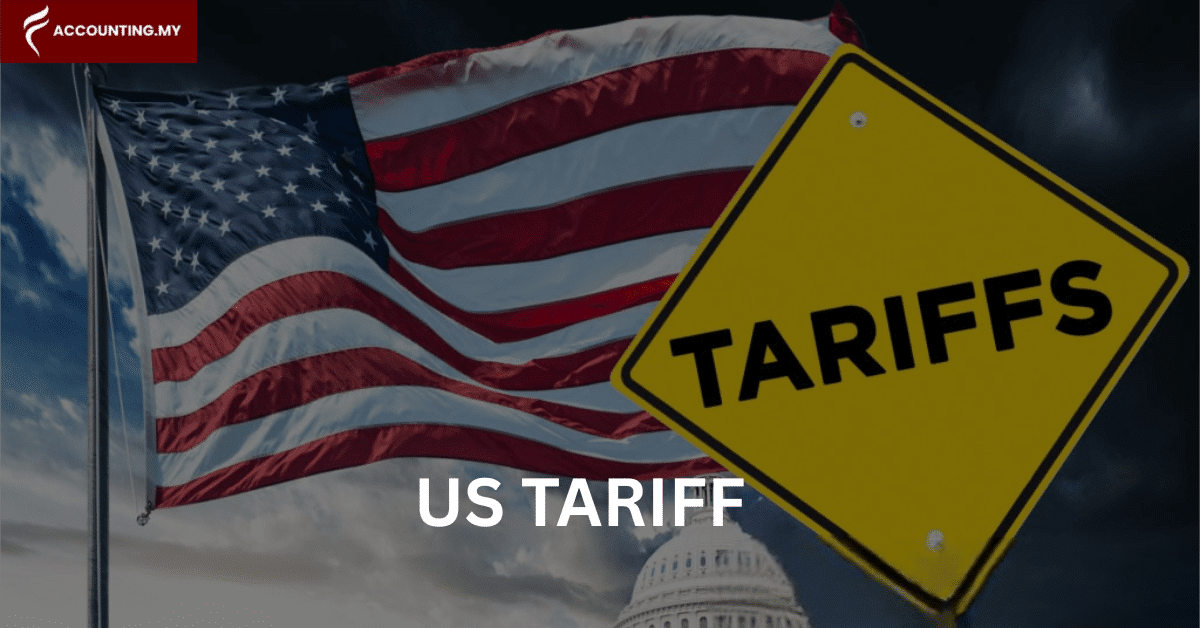On April 9 2025, US President Donald Trump slapped every country with reciprocal tariffs, with Malaysia among the affected. At 24% high, it is considerably lower compared to other neighbouring nations such as Vietnam (46%), Cambodia (49%) and Indonesia at (32%).
Despite initial insistence on a firm, aggressive trade strategy, a 90-day tariff pause was announced for most countries, excluding China, whose import taxes were significantly raised to 245% at the time of writing. This reprieve, setting a blanket 10% tariff for non-retaliating countries until July, highlights the uncertainty many businesses, companies and enterprises face in this economy.
Naturally, questions regarding would there be a recession, how does it affect Malaysian business owners? What if the trade war escalates? Are we doomed?
We understand the concern and anxiety, and we will dive into the details to provide a clearer picture, and offer some financial management strategies to navigate these challenging times.
What Is Tariff?
Simply put, a tariff is a tax imposed by one country on goods imported from another country.
When your products, or the materials you need, cross that border into the United States, this extra cost gets slapped on. The idea behind these Malaysia US tariff can vary, from trying to protect local industries in the US to addressing trade imbalances. In this case, US President Trump has chosen both.
If you are a business owner whose primary export market is the United States, especially in sectors such as furniture and electronic goods, then you have likely experienced the effects of these tariffs in your industry.
The Effects Of US Tariff On Malaysia Exporters
For Malaysian businesses involved in exporting to the US, or those integrated into supply chains that ultimately serve the US market, this presents a considerable challenge. The US is the world’s largest consumption economy, with a nominal GDP estimated at around USD 29.7 trillion in 2024. Their high demand in goods, services and energy would naturally affect Malaysian exporters doing trade with the US.
Direct Impact on Exporters
If you’re a Malaysian business directly exporting goods to the United States, you are now likely facing a 10% tariff under the temporary blanket measure for non-retaliating countries. While lower than the initial 24%, this is still extra cost for American buyers.
This can still make your products less competitive compared to domestic US producers or suppliers from countries that might have specific exemptions or preferential trade agreements.
Consequently, you will see a decrease in sales volume or be forced to absorb some of the tariff cost, squeezing your profit margin.
Impact on Supporting Industries
Businesses in Malaysia that supply components or services to these direct exporters will also feel the pinch. If the exporters’ sales to the US decline, their demand for your products or services will likely follow suit.
Here’s an hypothetical example:
Consider a logistics provider based in Johor. Their services are specifically geared towards assisting Malaysian manufacturers in the furniture industry to export their goods to the United States. This provider manages everything from arranging transportation from the factory to the port, handling all export documentation and customs procedures in Malaysia, to coordinating with shipping lines for delivery to the US.
If US tariffs increase the cost of Malaysian furniture makers for American buyers, leading to lower sales, this Johor-based logistics provider would likely experience a decrease in shipping volumes and demand for their services, directly affecting their business.
Currency Fluctuations and Exchange Rate Risks
The imposition of US tariffs and the broader trade tensions can lead to fluctuations in exchange rates, particularly the MYR against the USD. A weakening Ringgit could make Malaysian exports cheaper for US buyers in USD terms, potentially offsetting some of the tariff costs.
However, it could also increase the cost of imported inputs for Malaysian manufacturers who rely on materials priced in USD, creating a double-edged sword.
The uncertainty surrounding currency movements adds another layer of complexity to export pricing. Since Trump’s tariff policies seemed to be shifting on a whim, it’s best to keep updated on the latest news and trends regarding tariffs.
How Tariffs Affect Local Businesses
Now, you might be thinking, “Well, I don’t directly export to the US, so this doesn’t concern me.”
But the truth is, the impact of these tariffs can spread like ripples in a pond, touching local businesses in unexpected ways when a big splash hits.
Increased Costs of Imported Goods
If your business relies on raw materials, components, or finished products that originate from or pass through countries facing these US tariffs, you might see a hike in your purchasing costs. Suppliers will likely need to factor in this extra expense, and that cost could trickle down to you.
Supply Chain Snags
International trade is a complex web. These tariffs can create disruptions in established supply chains. Businesses that previously had smooth sailing might find themselves facing delays, shortages, or the need to find alternative (and potentially more expensive or less reliable) sources.
Reduced Demand from US Buyers
If your business, directly or indirectly, supplies goods to companies in the US, those companies might face higher costs due to the tariff. This could lead them to reduce their orders or temporarily withhold them until further announcement or market changes.
The Threat of Retaliation and Job Losses
Following the US tariff announcements, China imposed its own retaliatory 125% tariffs on some American goods. As Malaysia’s largest trading partner, the total trade between Malaysia and China amounted to approximately RM484.12 billion in 2024.
A significant portion of Malaysia’s exports to China falls under electrical and electronic (E&E) products, including components like semiconductors, integrated circuits, and parts for electronic devices, valued at billions of Ringgit annually.
If Chinese manufacturers and factories on Dongguan who rely on these Malaysian E&E components to produce finished goods (such as smartphones, computers, or telecommunications equipment) face a drastic reduction in their US market access due to the 245% tariffs, they will inevitably scale back their production.
This decreased production will directly translate to a lower demand for Malaysian-made semiconductors and other important electronic components, impacting a key export sector for Malaysia and potentially leading to reduced revenue and even job losses within the Malaysian E&E industry.
Read more: 13 Questions To Ask Your Accountant For Small Business
What’s The Next Move For Businesses?
The situation does seem dire and gloomy for Malaysia’s businesses and economy, so what can you do in the face of these US tariffs? What sort of financial risk management or strategies can you execute in this troubling market?
1. Thorough Assessment of Impact
- Detailed Analysis: Businesses need to conduct a detailed analysis of how the US tariffs directly and indirectly affect their operations. This includes evaluating the increased costs of exports, potential disruptions to supply chains (both imports and exports), and the potential impact on demand from US buyers.
- Scenario Planning: Develop multiple scenarios based on different potential future developments in US trade policy, such as the 10% tariff becoming permanent, targeted tariffs on specific Malaysian goods, changes in tariffs on China. This will help in formulating contingency plans.
2. Diversification of Export Markets
- Explore Alternative Regions: Actively explore and invest in diversifying export markets beyond the United States. Focus on regions with strong growth potential and existing or potential free trade agreements, such as our fellow ASEAN countries, the European Union, and of course China.
- Strengthen Existing Partnerships: Enhance relationships with existing trade partners to compensate for potential reduced demand from the US. This is what Malaysia is actively doing at the moment, so keep your eyes peeled from any shift in macroeconomic policy or incentive from the government.
3. Supply Chain Resilience and Optimisation
- Identify Alternative Sourcing: Investigate the possibility of sourcing raw materials and components from countries not significantly impacted by US tariffs. This might involve exploring new suppliers or restructuring existing supply chains.
- Localisation Where Feasible: For certain businesses, explore the feasibility of increasing local sourcing to reduce reliance on imports that might be subject to tariffs or affected by global trade disruptions.
4. Leveraging Technology and Innovation
- Automation and Digitalisation: Adopt automation and digitalisation technologies to improve productivity, reduce labor costs, and enhance overall efficiency.
- E-commerce and Direct-to-Consumer Models: Explore direct-to-consumer sales channels in the US through e-commerce platforms to potentially bypass some traditional import and distribution costs. Some manufacturers in China are already using Xiaohongshu to do just that.
5. Government and Industry Collaboration
- Advocacy and Engagement: Work collectively through industry associations to engage with the government and advocate for policies that can mitigate the impact of US tariffs, such as exploring trade negotiations or providing support for affected industries.
- Utilize Government Support Programs: Explore and leverage any government programs or incentives aimed at assisting exporters in diversifying markets or enhancing their competitiveness.
6. Focus on Regional Opportunities
- Capitalise on ASEAN Economic Community: Fully leverage the opportunities presented by the ASEAN Economic Community (AEC) to expand trade and investment within the region.
- Explore RCEP Benefits: Utilise the Regional Comprehensive Economic Partnership (RCEP) agreement to access wider markets and potentially offset challenges in the US market.
Potential Opportunities Amidst Trade Tensions
While US tariffs present challenges, there is opportunity amidst the chaos.
1. Malaysia as a “China+1” Destination
The ongoing trade tensions between the US and China have prompted many MNCS to adopt a china plus one strategy. This involves diversifying their supply chains and manufacturing footprints beyond China to mitigate risks associated with tariffs and geopolitical instability.
Malaysia, with its established manufacturing capabilities, stable political environment, and skilled workforce, can position itself as an attractive alternative or complementary location for these MNCs.
The country could see a surge FDI from companies looking to establish or expand operations in Malaysia as part of their diversification efforts.
2. Relocation and Diversification by Chinese Businesses
Faced with high US tariffs on their exports, some Chinese businesses might consider relocating or establishing manufacturing facilities in countries like Malaysia.
This allows them to export to the US with potentially lower tariff burdens This influx of Chinese investment and manufacturing expertise could boost specific sectors within Malaysia and create new job opportunities.
Malaysian and Chinese businessmen could form joint ventures to capitalise on this shift.
3. Filling Supply Chain Gaps
As US buyers seek to reduce their reliance on imports from China due to high tariffs, Malaysian businesses in sectors that compete with Chinese exports to the US could see a surge in demand.
For example, if the US imposes high tariffs on certain electronics or machinery from China, Malaysian manufacturers of similar goods might find increased opportunities to fill those supply gaps in the American market.
4. Opportunities in Services and Technology
Beyond manufacturing, the trade war could also create opportunities in service sectors. For instance, increased FDI into Malaysia might drive demand for Malaysian professional services (legal, financial, consulting).
Furthermore, collaborations in technology and R&D could emerge as both Malaysian and foreign companies seek innovative solutions to navigate the changing trade environment.
Conclusion On US Tariffs Affect Malaysian Businesses
Malaysian exporters, especially those in key sectors like electronics and furniture, face increased costs and razor thin margins in the US market. The effects of globalisation means that even businesses without direct US exports can be indirectly affected by disruptions and the economic impact on major trading partners like China, which faces retaliatory tariffs.
In such a complex and ever-changing environment, seeking financial accounting advice is more important than ever to navigate these financial challenges effectively.
Accounting.my has the expertise to help you accurately calculate the impact of tariffs on your product costing, assess changes to profitability, and optimise pricing strategies to maintain competitiveness.
Frequently Asked Questions About US Tariffs
The future after July is uncertain. The US administration could reinstate the original tariff levels, implement new rates, or extend the pause depending on trade negotiations and domestic economic factors.
While the current situation involves a broad 10% for non-retaliating nations, specific exemptions could be negotiated or implemented for certain product categories in the future.
Malaysian companies producing goods that directly compete with heavily tariffed Chinese exports in the US market may see increased demand and potentially higher selling prices.
The Malaysian government might consider support measures such as tax breaks, export promotion initiatives, or financial assistance for affected sectors, but specific plans would need to be announced.
Challenging tariffs often involves complex international trade law and is typically pursued by national governments or large industry groups rather than individual businesses.
SMEs should seek guidance from trade consultants, professional accountants, and government agencies to understand US customs procedures and tariff regulations.















